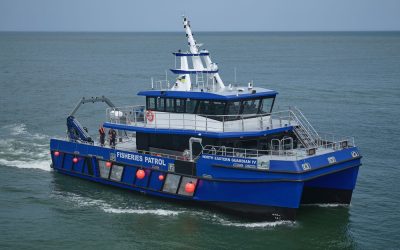For a compact uncrewed vessel, the Oceanus12, developed by Zero USV, promises an extensive reach when it comes to truly autonomous, AI-supported missions in high sea states, writes Stevie Knight.
To start with, Zero USV has initially committed to a fleet of a dozen fully autonomous boats, but these will be ‘guns for hire’: the group is not setting itself up as a survey company. Further, it is utilising a rather unusual build process which will allow global market reach.
Finally, the design is a straightforward monohull. That’s a departure from its predecessor, the 14.8m Mayflower, which made it from the UK to a safe landing at Plymouth, US in 2022, minus crew – but which did so with three sleek and rather futuristic-looking hulls.
So, why the change? When it comes to creating a working fleet rather than a long-range one-off, “you don’t gain that much from a multihull design”, Matthew Ratsey, MD of Zero USV, tells Ship & Boat International. In fact, there can be distinct disadvantages to taking a multihull approach. While they might yield more stability, multihulls typically don’t move ‘with’ the sea so well. “They can present some rather odd behavioural characteristics in larger waves,” Ratsey adds. This can reduce their usefulness for certain activities: for example, both survey and lift equipment have an easier time when adjusting to a smoother motion.
In contrast, he points out: “The advantages of a single hull [include] reduced build expenses and generally better performance in higher sea states. It means a very wet deck, but the vessel is self-righting…and, since there’s nobody on board, that genuinely doesn’t matter.”
The result is an 11.5m x 2.3m monohull with a load-carrying bay at the rear, scaled to hold two standard Euro pallets. However, Ratsey says: “What people do with that space is totally up to them. For example, you could put in a winch and towing array – or, if range is the most important element, you could install a bladder to hold additional fuel.”
The USV has true over-the-horizon autonomy. “A lot of what’s out there at the moment is effectively operating by remote control,” Ratsey explains. “But, in the real world, you’re going to get outages, which could be 12+ hours at a time, so the boat has to be able to carry on, avoiding other ships.” As a result, the Zero USV team has put enough intelligence inside the vessel to allow it to continue working within the COLREGs framework, no matter the state of the satellite link. This ‘edge computing’ model was installed aboard and proven by Mayflower, which embarked on its transatlantic crossing with nothing more than an Iridium installation – “which is a bit like going back 30 years to a dial-up modem”, Ratsey says.
The Guardian AI software behind it all was supplied by Zero USV’s sister company, Marine AI. Not only has this ditched reliance on a continuous connection but, by today’s standards, it doesn’t require huge amounts of computing power: “You don’t need anything like a server rack to run it,” Ratsey underlines. Guardian AI combines features such as real-time weather, current and AIS data with local sensors, computer vision and complex modelling to make automatic decisions related to speed, course and direction, to optimise safe navigation and fuel efficiency.
Inside the hull, the Oceanus12’s powertrain comprises two gensets that can run on HVO. Alongside this is 60kWh of energy storage. This is fairly modest, Ratsey admits, commenting: “We couldn’t begin to put enough capacity in it for the boat to operate on batteries alone for any great length of time.” However, this installation will act as a buffer for the generator loads, and will permit low-speed, silent running for shorter periods: handy for scientific experiments or journeys in environmentally restricted areas.

Matthew Ratsey, Zero USV (left, pictured with Dan Hook of RAD Propulsion): the Oceanus12 is equipped with twin 40kW RAD units
On the back are twin 40kW units from RAD Propulsion. All this is configured through a high-voltage, 400V distribution which allows for much smaller cable sizes. That was one of the takeaways from the Mayflower project: “Those ran at 48V and some of the cables were like an elephant’s trunk,” says Ratsey. “Here, they’re probably no thicker than your finger.”
The build is aluminium – in a way, one of the most important design elements. “My guess is that, at first, people are going to justify using them in extremes – in high latitudes, dangerous seas and/or in places where you don’t want to put crew,” says Ratsey, “so I think these boats are going to be employed doing the hard stuff before the easy stuff.”
It also suits the build. “Going down the GRP route means making a plug and a mould,” he continues, “so you’re committed to two levels of tooling before you even get to make a boat.” As such, it leaves little elbow room to sort out potential issues: something that’s best done during development. “I’m quite old-school,” Ratsey admits, “but with all the new 3D design possibilities, ‘thinking time’ has become a lot cheaper than ‘doing time’, especially as you can make your mistakes on the screen, long before you press ‘go’.”
He adds: “There are also the horrendous issues related to recycling GRP. We don’t want to add to that.” The company’s solution is a complete, prefabricated aluminium package.
There are more significant advantages. “When it arrives at the yard – for example, at Manor Marine in Portland, UK, which is building the Oceanus12 units – the kit is ready to go, with everything from the keel to the fit-out,” says Ratsey. “It means we know that they’re being built to a known standard and known tolerances.”
TECHNICAL PARTICULARS: Oceanus12
Length, oa: 11.55m / Breadth, oa: 2.33m / Draught: 1.76m / Displacement: 4tonnes / Cruise speed: 6knots / Sprint mode: 10knots / Endurance: 2,000nm+






